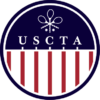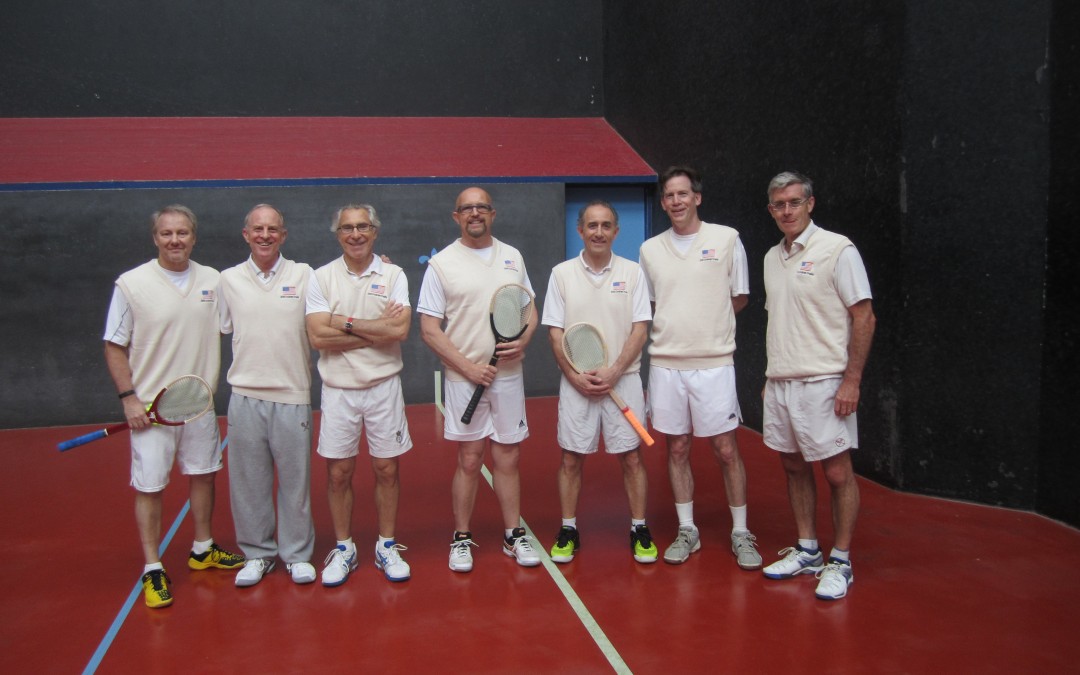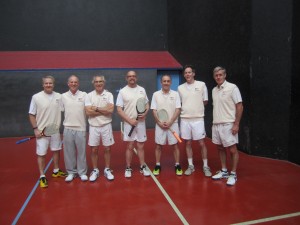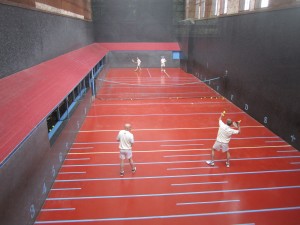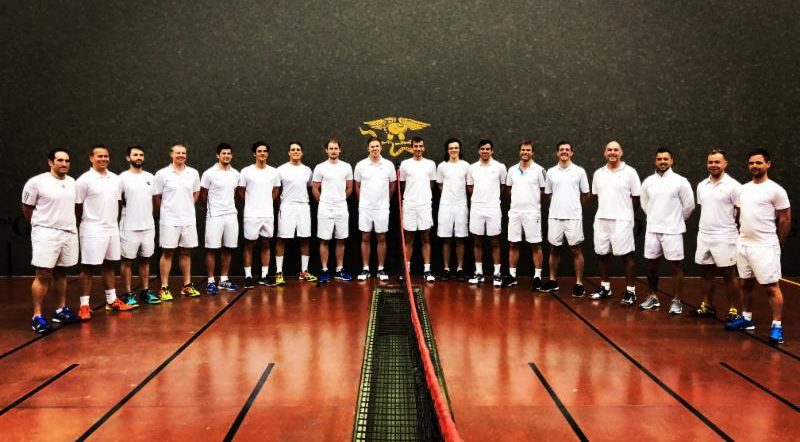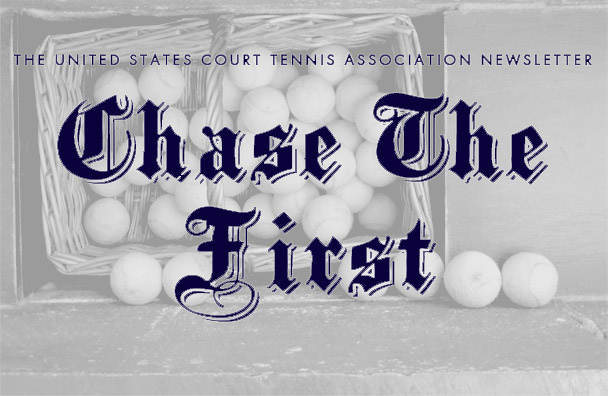U.S. Cockram Players Bond Over the Pond
By Steve Hufford
In spite of having seven players from five different clubs, or perhaps because of it, the US Cockram Trophy squad quickly formed a cohesive cadre of teammates, cheering each other on and providing useful advice, consolation, and congratulations.
We began our team practice on Monday, May 11 with three hours of structured play, and started to learn the features of the Cambridge blue court: very lively back walls, “sticky” side walls that pop the ball out sideways, and natural lighting that varies with the patchy sunshine of the English spring.
Our hosts’ hospitality was unparalleled. After practice, we were invited to the house and grounds of George Pearson, President of the Cambridge University Real Tennis Club. George and his wife Jane were gracious in fueling us with champagne and hors d’oeuvres from just about all the cuisines in the British Empire. With dessert, we enjoyed views of their lovely wisteria-draped house, extensive gardens, grass tennis court, and landscaped grounds stretching past the meanders of their stream to the River Cam.
On the morning of May 12 we began our contest against Great Britain, following the standard order of play for the Cockram competition: first doubles, third singles, first singles, second singles, second doubles. Whatever the reason for that order having been codified, it puts significant pressure on the second doubles team when the contest is tight. We were in good position at that spot, with David Schenkein and Linc Frank, former college lawn tennis teammates, paired to bring their team chemistry to bear on our behalf.
Alas, against Great Britain, the load was light by the time it was placed on their shoulders. Anders Cohen and Steve Hufford played at first doubles, and all was well until 5-5 in the first set when the British pair, William Maltby and Mark Nicholls, asserted themselves, closed out the set 6-5 and went on to steamroll the second set 6-0. We did, however, catch their attention in the first set and give notice that the US would contest every match, in spite of significant handicap differentials favoring the British.
Mark Philpott, playing third singles, had the toughest assignment of the day, playing against Simon Shenkman, a player with a handicap twenty points lower than Mark’s. Mark strove mightily and unflaggingly, and continued to keep things interesting as he eventually fell 6-1, 6-0.
With Britain up 2-0 after two matches, it was time for Bill Barker, playing at first singles, to show his brand of patriotism. Bill did so by humbling the British captain, David Watson, in the first set by the score of 6-1. It was an amazing display of control, shot selection, pace, athleticism, and maybe a little good luck. The battle continued as before until 4-4 in the second set, and the British spectators saw the prospect that their man could quickly go down in straight sets. David Watson, however, drew on his years of experience, found some ways to counter Bill’s attacks, and took the second set 6-4. David moved through the third set a bit more quickly, winning it 6-1. That clinched the team victory for Great Britain, as they were up 3-0 with only two matches remaining.
Alan McHugh played second singles against John Prenn. Alan worked hard to adjust to the court and to Mr. Prenn’s significant arsenal, but dropped the first set 6-0. Alan then found some solutions, adjusting the length of his boast to better match the court, yet lost the competitive second set 6-3.
With their teammates having showed much determination in the face of adversity, Linc Frank and David Schenkein stepped on court at second doubles, ready to demonstrate their teamwork and communication and best play. Against Simon Barker and Mark Openshaw-Blower, a team favored by 18 handicap points, they did just that. Linc and David played an extremely competitive match in the face of the differential, falling 6-3, 6-1. No one made it easy for the home team, and the US players acquitted themselves very well overall.
By the numbers we were not expected to win, and we lived up to expectations! We did, however, make many of the matches, sets and games exceedingly interesting. The spectators enjoyed some rare treats, as did the excellent markers Kees Ludeckens, Scott Blaber, and Peter Paterson.
We faced Australia on Wednesday, bringing a slightly different lineup with Alan and Mark at first doubles, and Anders and Steve in at singles. Thanks to the challenges of traveling from Australia, their side was quite different in strength than the British team. In addition, we had the benefit of the prior day’s hard experience on court against the British.
With all that, Wednesday went our way, as we brought our 350+ years of experience to bear. As the first doubles match began, we were heartened to see that the Australians felt a need for over 360 years of experience, as evidenced by bringing Dick Friend down from their Bostwick Cup squad to complete their Cockram lineup. Dick paired with Jon Isles against Mark and Alan, but his additional experience couldn’t overcome Mark and Alan’s determined, authoritative, and intelligent play, as the US won 6-1, 6-2 in a fine start.
The new pattern continued at third singles, with Anders Cohen hitting a wide variety of railroad serves and spending most of the match on the service end. Anders remained focused throughout and dismissed Australia’s Paul Williams 6-2, 6-2.
Bill Barker, at first singles, was the sole US player on Wednesday facing an opponent of lower handicap. Once again, he played a match that shocked his favored opponent, the Australian team captain Richard Hince. Perhaps as a vestige of his grueling match with David the day before, but perhaps due to Richard’s amazing ball striking, Bill got off to a slow start and dropped the first set 6-3. He turned it around in the second set and won that one 6-3. The Australian spectators, seeing their ‘skipper’ on the ropes, saw the possibility of a quick 0-3 team defeat, and encouraged him onward with vocal support. Richard managed to close out an extremely hard-fought third set 6-4. Bill left nothing unused in the tank, and it was an excellent showing.
Steve Hufford, US captain, was up next against Peter Dunn, a higher-handicapped player who had been shifted from doubles to singles only when the Australian side found they were short-staffed. Steve found some serves that seemed to shackle Peter’s aggression, and used his court coverage to good effect in chasing down a lot of balls. As a result, Peter spent much of the match on the hazard end. The US prevailed 6-0, 6-0 thereby clinching the team match 3-1.
With little weight on their shoulders, David Schenkein and Linc Frank played freely in the final match at second doubles. Their longstanding partnership was in evidence as they consistently worked their way to a 6-3, 6-3 victory over John Piccolo and Vince Scopelliti. Linc was hobbled by severe tightness in his lower back, but the two doctors on our squad had provided some pre-match medications along with effective medical advice: hit your volleys to the base of the tambour. It was a good prescription, and the points ended quickly.
Our hosts arranged a fabulous Wednesday evening dinner for all the Masters age-group teams at the Jockey Club Rooms in Newmarket, preceded by tours of the extensive artwork and artifacts. The beauty of the Stubbs counterbalanced the slightly macabre snuffboxes made from the hooves of famous sires and Munnings horse portraits and an historic horsing whip from Charles II. All who gathered enjoyed a fine meal, good company and full recovery from the rigors of the day.
The end result of our competition was a 0-5 loss to Great Britain, a 4-1 victory over Australia, and a .500 batting average for the US Cockram Trophy team. It was a strong showing by a squad that had only two returning Cockram veterans. With five first-time players, the team represented the USCTA and the US well, demonstrated the best ideals of sportsmanship, and laid the groundwork for two years hence.
